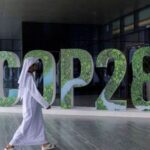Energy News Beat
WASHINGTON, Nov 20 (Reuters) – The U.S. will lay out the first international strategy to commercialize nuclear fusion power at the upcoming UN climate summit in Dubai, U.S. Special Envoy on Climate Change John Kerry will say on Monday, two sources familiar with the announcement said.
Fusion could have an important advantage over today’s nuclear fission plants that split atoms, as it does not produce long-lasting radioactive waste. If deployed successfully, it could also provide a cheap source of carbon-free electricity.
The former secretary of state will announce his plan to lay out the strategy that foresees strengthened cooperation with other countries aiming to speed commercialization on a tour of fusion company Commonwealth Fusion Systems near Boston. The UK and the United States on Nov. 8 signed a cooperation agreement on fusion.
Fusion, the process that powers the sun and stars to generate electricity, can be replicated on Earth with heat and pressure using lasers or magnets to smash two light atoms into a denser one, releasing large amounts of energy.
In August, scientists using laser beams at a national lab in California repeated a fusion breakthrough called ignition where for an instant the amount of energy coming from the fusion reaction surpassed that concentrated on the target.
Kerry, who as a U.S. senator more than a decade ago backed legislation that would fund fusion research at the Massachusetts Institute of Technology, will tour Commonwealth with Claudio Descalzi, CEO of Italian energy company Eni (ENI.MI). Eni is working on four fusion research partnerships in Italy and the U.S., including one with Commonwealth.
“I will have much more to say on the United States’ vision for international partnerships for an inclusive fusion energy future at COP28,” Kerry said in a statement.
Decades of federal investment is transforming fusion from an experiment to “an emerging climate solution”, he added.
HURDLES
But there are hurdles to fusion’s producing commercial electricity. The energy output of last year’s fusion experiment at the U.S. National Ignition Facility was only about 0.5% of the energy that went into firing up the lasers, some scientists estimate.
Scientists have so far only reached scattered instances of ignition, not the many continuous ignition events per minute needed to generate electricity to power homes and industries.
There are also regulatory, construction and siting hurdles in creating new fleets of power plants to replace parts of existing energy systems.
Some critics say fusion will be too expensive and take too long to develop to help in the fight against climate change in the foreseeable future.
A source familiar with the planned announcement said the fusion strategy will be a framework that lays out plans for the global deployment of the technology that could gain support from international partners.
The source said COP28, which runs from Nov. 30 to Dec. 12, will “be the starting gun for international cooperation” on nuclear fusion, which Kerry will tout as a climate “solution, not a science experiment”.
Despite what scientists say is an urgent need for an energy transition to fight climate change, investment has slowed into many parts of the clean energy business this year due to economic uncertainty and inflation.
In 2023, international fusion companies have garnered about $1.4 billion in investments for a total of about $6.21 billion in mostly private money, the Fusion Industry Association (FIA) said, down from about $2.83 billion in new investment last year.
But the number of companies getting investments rose to 43 from 33, spanning a dozen countries, according to the FIA, including the U.S., where Commonwealth is one of about 25 companies. Other countries pursuing fusion include Australia, China, Germany, Japan, and the UK.
Of the two main types of fusion, one uses lasers to concentrate energy on a gold pellet containing hydrogen.
The other, on which Commonwealth and many other companies are focusing, uses powerful magnets to trap plasma, or gaseous hydrogen heated to about 100 million degrees Fahrenheit (55 million degrees Celsius) until atoms fuse.
ENB Top News
ENB
Energy Dashboard
ENB Podcast
ENB Substack
The post US to announce global nuclear fusion strategy at COP28 appeared first on Energy News Beat.








